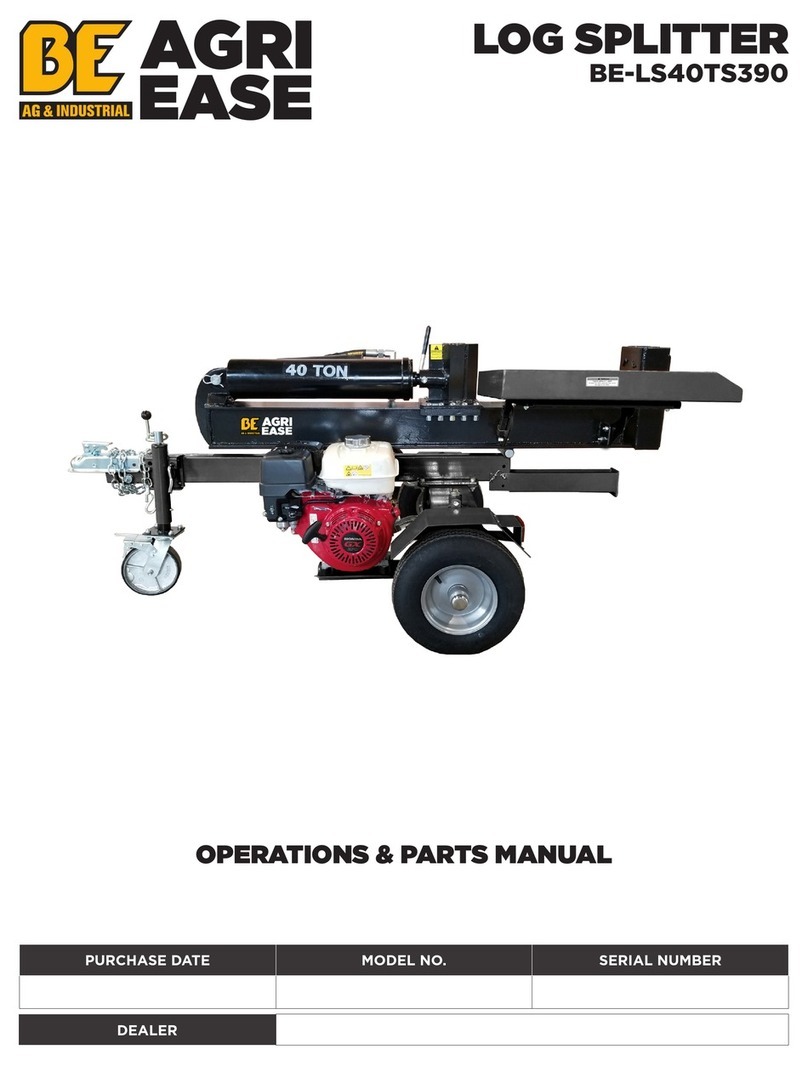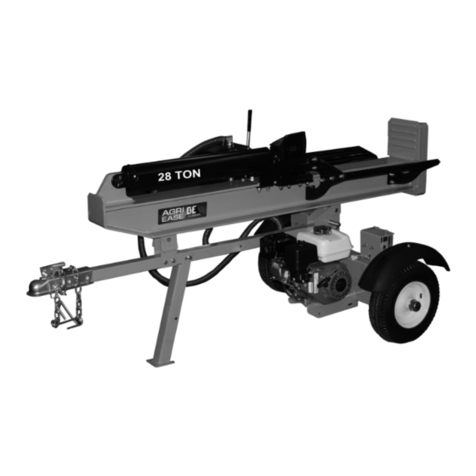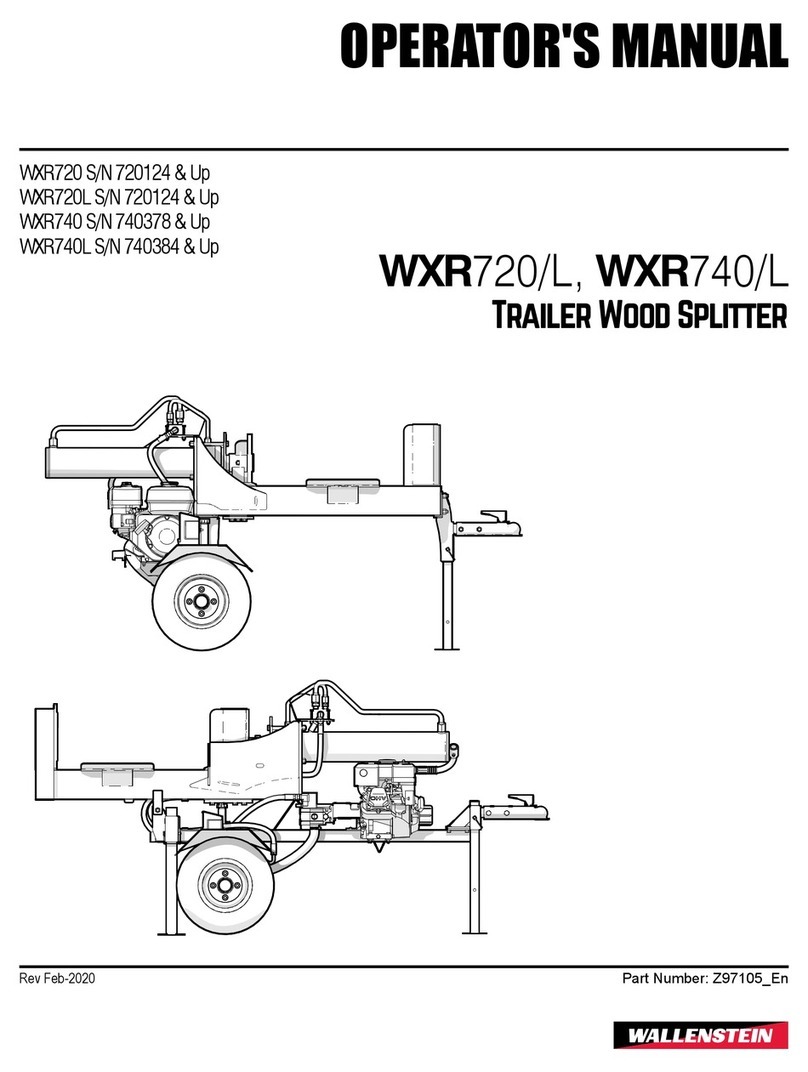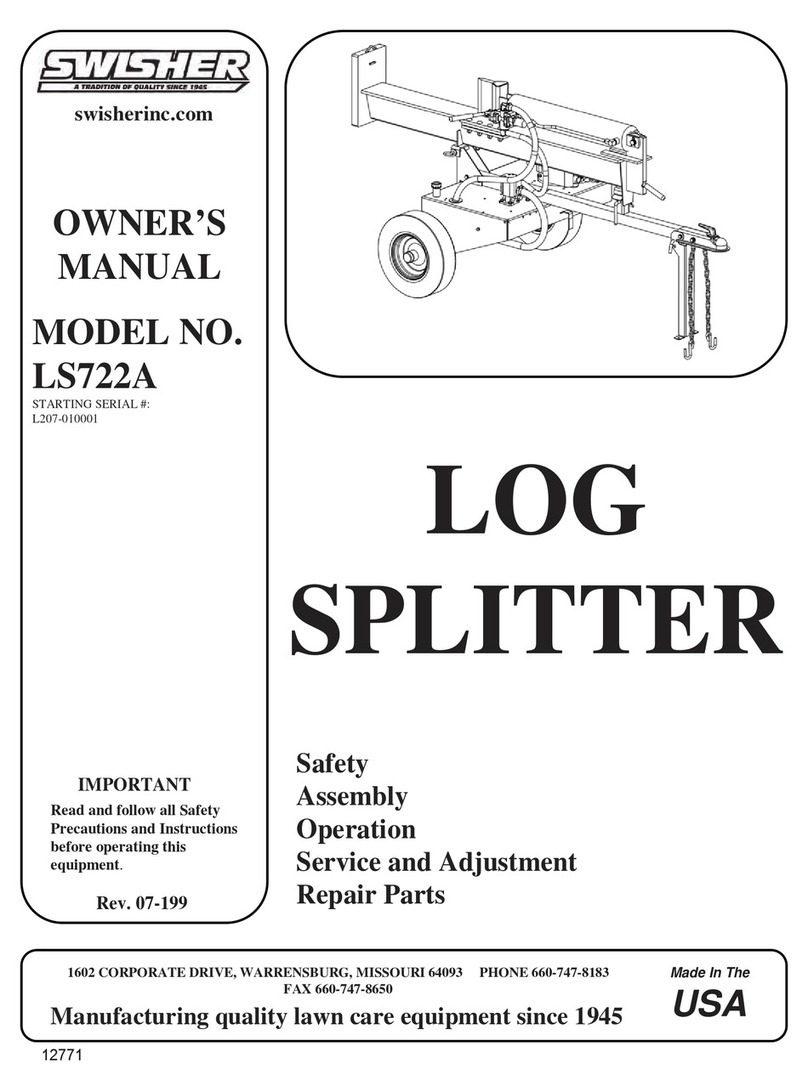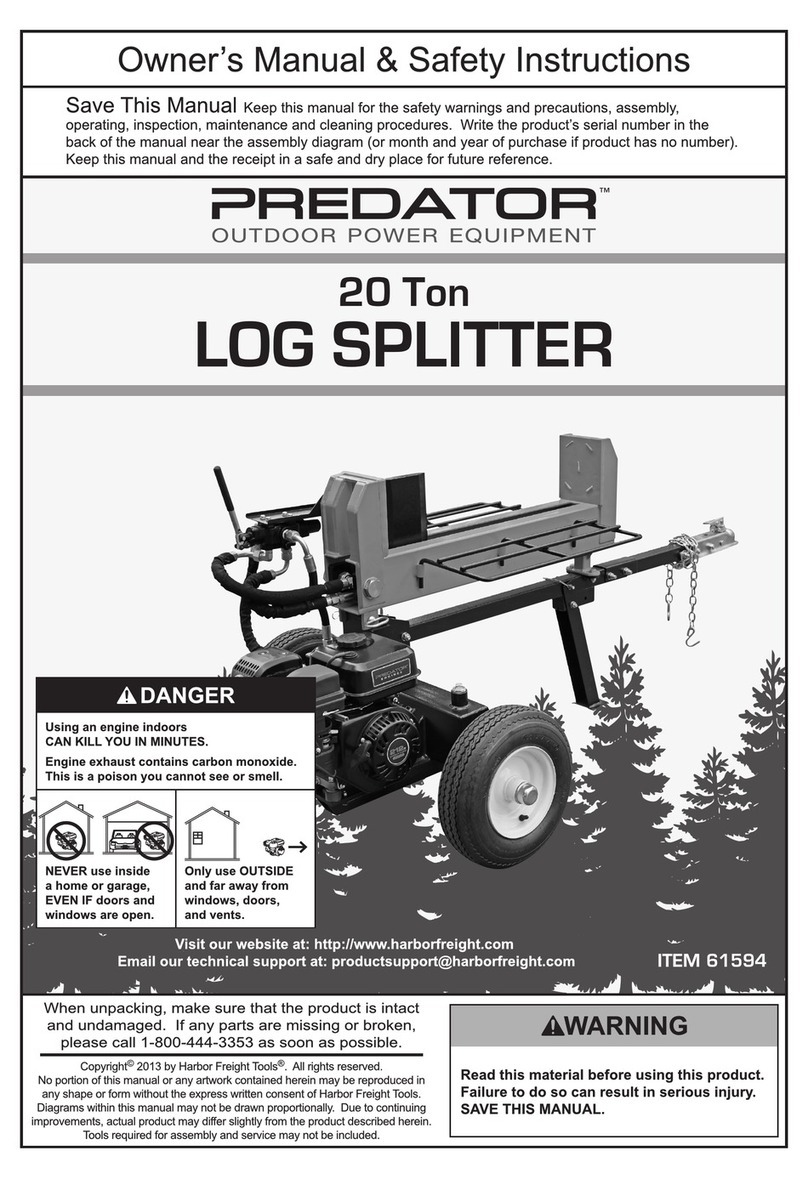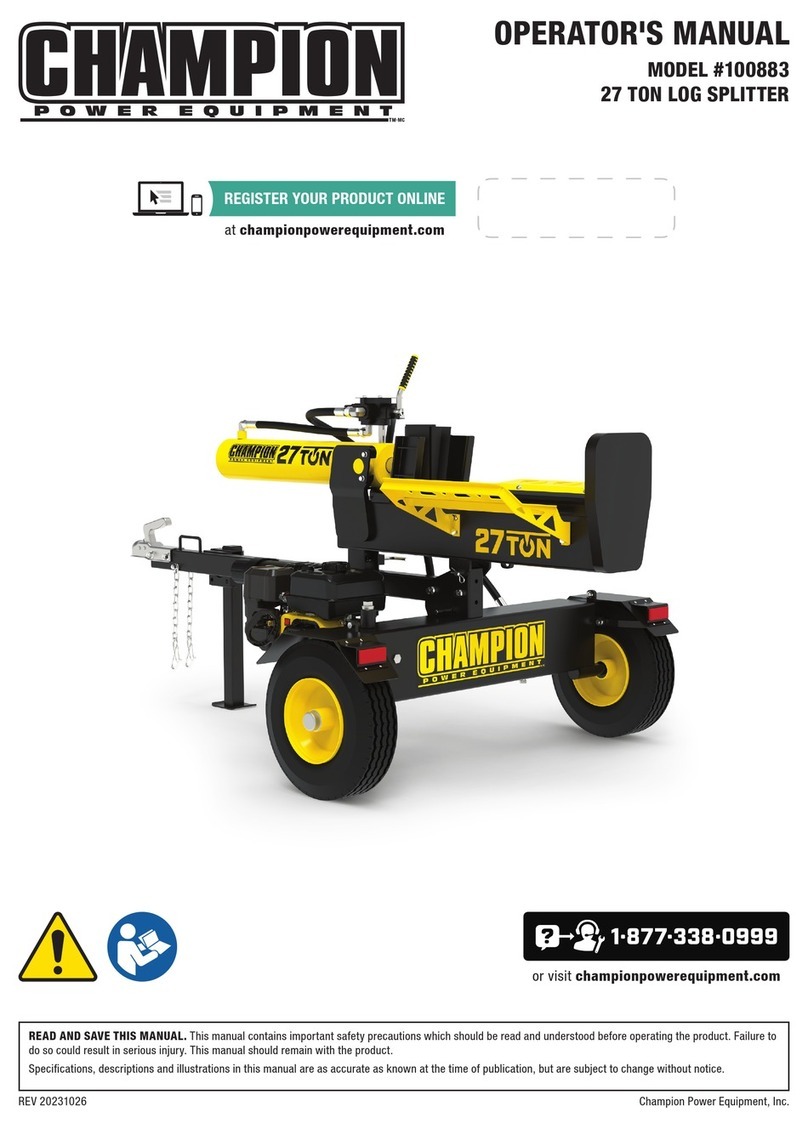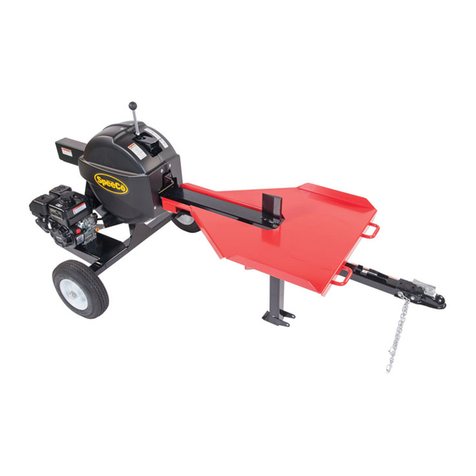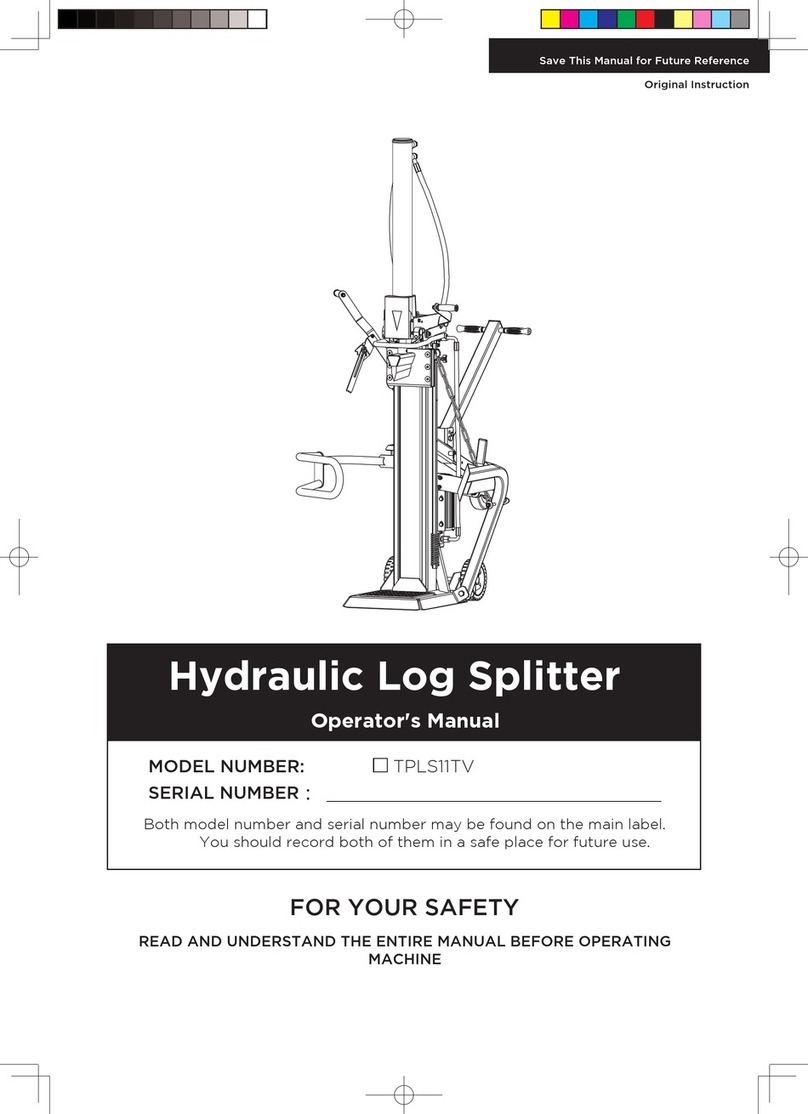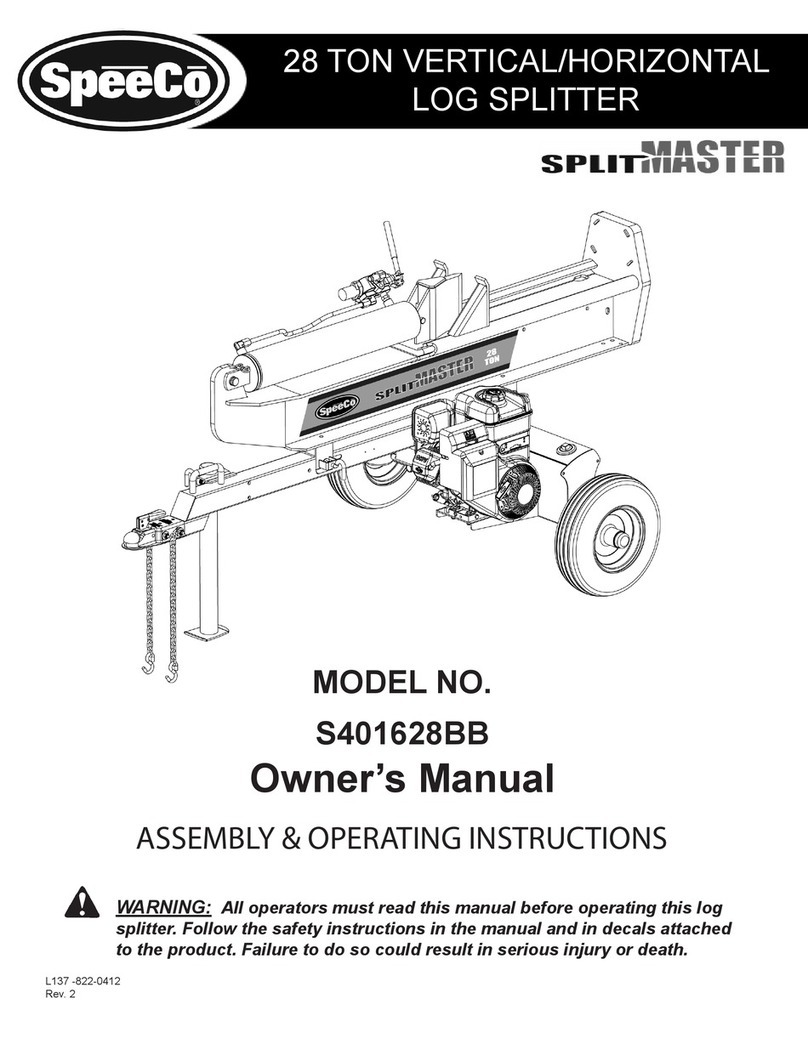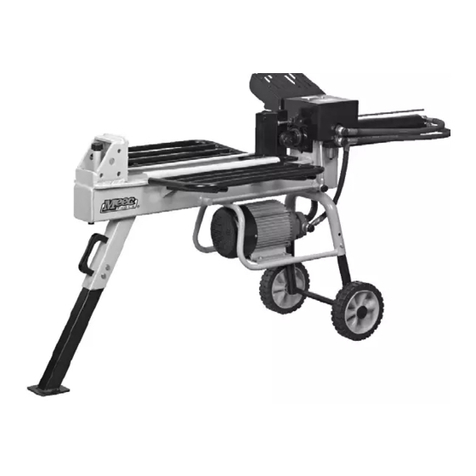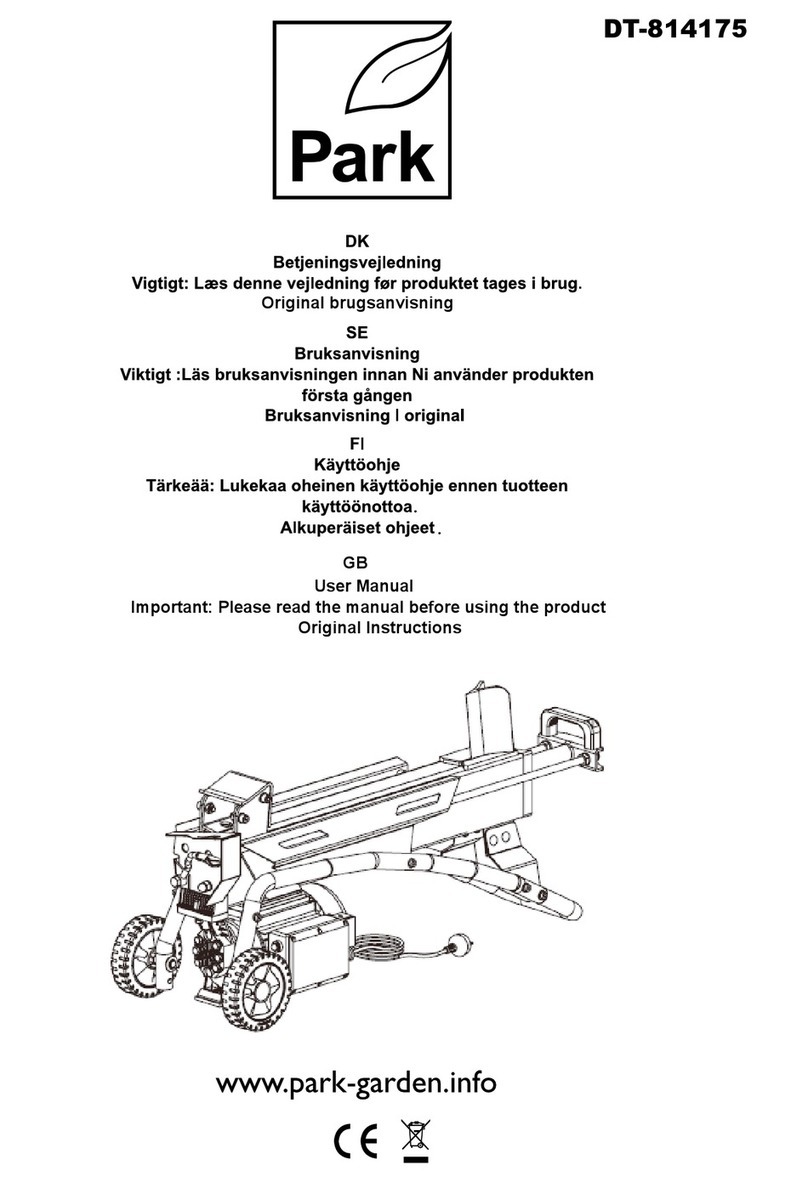BE Ag & Industrial Agri Ease BE-LS25TLE5GC User manual

OWNERS MANUAL
BE-LS25TLE5GC/BE-25TLE65GX
ASSEMBLY & OPERATING INSTRUCTIONS
Purchase Date ____________ Model NO. _____________ Serial NO. ______________
Dealer _________________________________________________________

To The Owner
Thank you for purchasing a BE AGRIEASE Log Splitter. It was carefully engineered to provide excellent
performance when properly operated and maintained.
Please read this entire manual prior to operating the equipment. It instructs you how to safely and easily
set up, operate and maintain your machine. Please be sure that you, and any other persons who will
operate the machine, carefully follow the recommended safety practices at all times. Failure to do so
could result in personal injury or property damage.
All information in this manual is relative to the most recent product information available at the time of
printing. Review this manual frequently to familiarize yourself with the machine, its features and operation.
Please be aware that this Operator’s Manual may cover a range of product specifications for various
models. Characteristics and features discussed and/or illustrated in this manual may not be applicable to
all models. We reserve the right to change product specifications, designs and equipment without notice
and without incurring obligation.
All the power testing information used to establish the power rating of the engine equipped on this
machine can be found at the engine manufacturer’s manual or website. If you have any problems or
questions concerning the machine, phone an authorized service dealer or contact us directly.
Braber Equipment reserves the right to discontinue, change, and improve its products at any time without
notice or obligation to the purchaser. The description and specifications contained in the manual were in
effect at printing. Equipment described within this manual may be optional. Some illustrations may not be
applicable to your machine.
Throughout this manual, all references to right and left side of the machine are observed from the
operating position. The engine manufacturer is responsible for all engine-related issues with regards
to performance, power-rating, specifications, warranty and service. Please refer to the engine
manufacturer’s Owner’s/Operator’s Manual, packed separately with your machine, for more information.

III
Table of Contents
Important Safety Information 1-10
General Safety Alert Signals 1
Safety Decals 2
Safety Symbols 3
Training 4
Pre-Operation 5
Operation 6
Operator Zone 7
Maintenance Safety 8
Fire Prevention 9
Towing Safety 10
Assembly & Set-Up Instructions 11-22
Unpacking the Container 11-12
Assembling 13-19
Set-Up 20-21
Know Controls and Features 22
Operating Instructions 23-26
Starting and Stopping the Machine 23
Operating Positions 23
Using Control Handle 24
Splitting the Wood 25
Transporting the Log Splitter 26
Maintenance and Adjustments 27-28
Troubleshooting 29
Specifications 30
Exploded Diagram & Parts List 31-34
Packing List 35

1
WARNING: Read and thoroughly understand all instructions in this manual and on safety decals before assembling
or operating this log splitter. Failure to do so may cause serious injury or death. Do not allow anyone to operate this
log splitter who has not read this manual. As with all power equipment, a log splitter can be dangerous if assembled
or used improperly. Do not operate this log splitter if you have any questions concerning safe operation.
This SAFETY ALERT SYMBOL identifies important safety messages in this manual.
Failure to follow this important safety information may result in serious injury or death.
IMPORTANT SAFETY INFORMATION
!
!
CALIFORNIA PROPOSITION 65
WARNING! Engine Exhaust, some of its constituents, and certain vehicle components contain or emit
chemicals known to State of California to cause cancer and birth defects or other reproductive harm.
!
DANGER! This machine was built to be operated according to the safe operation practices in this
manual. As with any type of power equipment, carelessness or error on the part of the operator can
result in serious injury. This machine is capable of amputating hands and feet and throwing debris.
Failure to observe the following safety instructions could result in serious injury or death.
!
DANGER Indicates a hazardous situation which, if not followed,
will result in serious injury or death.
WARNING indicates a hazardous situation which, if not avoided,
could result in serious injury or death.
CAUTION indicates a hazardous situation which, if not avoided,
could result in minor or moderate injury.
NOTICE is important information about the proper use of your machine.
Failure to follow this instruction could result in damage to your machine or property.
DANGER
WARNING
CAUTION
NOTICE
!
!
!
The following signal words & meanings are intended to explain the levels of risk associated with this product.

2
SAFETY DECALS
IMPORTANT SAFETY INFORMATION
!
Make sure all safety wanring decals are in good condition and readable. Always replace missing or defaced decals.
Part #: 410-188
Part #: 410-249
Part #: 410-237
Part #: 410-233
Part #: 410-647
Make sure that all safety warning decals are in good condition and readable. Always replace missing or defaced decals.
Contact BOSS at 1-800-780-2677 for replacement decals.
SAFETY DECALS
Page 2
Part #: 410-188
Part #: 410-249
Part #: 410-237
Part #: 410-233
Part #: 410-647
Make sure that all safety warning decals are in good condition and readable. Always replace missing or defaced decals.
Contact BOSS at 1-800-780-2677 for replacement decals.
SAFETY DECALS
Page 2
Part #: 410-188
Part #: 410-249
Part #: 410-237
Part #: 410-233
Part #: 410-647
Make sure that all safety warning decals are in good condition and readable. Always replace missing or defaced decals.
Contact BOSS at 1-800-780-2677 for replacement decals.
SAFETY DECALS
Page 2
Part #: 410-188
Part #: 410-249
Part #: 410-237
Part #: 410-233
Part #: 410-647
Make sure that all safety warning decals are in good condition and readable. Always replace missing or defaced decals.
Contact BOSS at 1-800-780-2677 for replacement decals.
SAFETY DECALS
Page 2
Part #: 410-188
Part #: 410-249
Part #: 410-237
Part #: 410-233
Part #: 410-647
Make sure that all safety warning decals are in good condition and readable. Always replace missing or defaced decals.
Contact BOSS at 1-800-780-2677 for replacement decals.
SAFETY DECALS
Page 2

3
This page depicts and describes safety symbols that may appear on this product. Read, understand, and follow all
instructions on the machine before attempting to assemble and operate.
READ THE OPERATOR’S MANUAL(S)
Read, understand, and follow all instructions in the manual(s) before attempting to
assemble and operate.
FACE PROTECTION
Always wear safety goggles or safety glasses with side shields, or a face shield when
operating this product as well as ear protection.
WARNING—MOVING WEDGE
Keep hands away from wedge,moving part, end plate,and partially split wood.
BYSTANDERS
Keep bystanders, helpers and children at least 25 feet away.
SINGLE OPERATOR
Only one person should operate the machine at a time. The adult who loads and stabilizes
the log must be the person who operates control handle.
WARNING—PRESSURIZED FLUID
Never check for hose leaks with your hands. High pressure fluid can escape through a pin
hole leak and cause serious injury by puncturing the skin and causing blood poisoning.
WEAR GLOVES
Always wear nonslip, heavy-duty protective gloves when operating this product.
WEAR SAFETY FOOTWEAR
Always wear nonslip steel-toed safety footwear when operating this product.
WARNING—GASOLINE IS FLAMMABLE
Allow the engine to cool at least ten minutes before refueling.
WARNING—CARBON MONOXIDE
Never run an engine indoors or in a poorly ventilated area. Engine exhaust contains carbon
monoxide, an odorless and deadly gas.
WARNING—HOT SURFACE
Engine parts, especially the muffler, become extremely hot during operation. Allow engine
and muffler to cool before touching.
SAFETY SYMBOLS
Symbol Description
WARNING! Your Responsibility—Restrict the use of this power machine to persons who read,
understand and follow the warnings and instructions in this manual and on the machine.
SAVE THESE INSTRUCTIONS!
Page 3
This page depicts and describes safety symbols that may appear on this product. Read, understand, and follow all
instructions on the machine before attempting to assemble and operate.
SAFETY SYMBOLS
IMPORTANT SAFETY INFORMATION
!
WARNING! Your Responsibility—Restrict the use of this power machine to persons who read,
understand and follow the warnings and instructions in this manual and on the machine.
SAVE THESE INSTRUCTIONS!
!

4
TRAINING
IMPORTANT SAFETY INFORMATION
!
1. Read, understand, and follow all instructions on the machine and in the manual(s) before attempting to
assemble and operate. Keep this manual in a safe place for future and regular reference and for ordering
replacement parts.
2. Be familiar with all controls and their proper operation. Know how to stop the machine and disengage them
quickly.
3. Never allow children under 18 years of age to operate this machine. Children 16 and over should read and
understand the instructions and safe operation practices in this manual and on the machine and be trained
and supervised by an adult.
4. Never allow adults to operate this machine without proper instruction.
5. Many accidents occur when more than one person operates the machine. No helper is allowed to assist in
stacking logs.
6. Keep bystanders, pets, and children at least 25 feet from the machine while it is in operation.
7. Never allow anyone to ride on this machine.
8. Never transport cargo on this machine.
9. Hydraulic log splitters develop high fluid pressures during operation. Fluid escaping through a pin hole
opening can penetrate your skin and cause blood poisoning, gangrene, or death. Give attention to the
following instructions at all times:
a. Do not check for leaks with your hand.
b. Do not operate machine with frayed, kinked, cracked, or damaged hoses, fittings, or tubing.
c. Stop the engine and relieve hydraulic system pressure by cycling the valve control lever from forward to
reverse several times while engine is not running. Return to neutral before repairing or adjusting fittings,
hoses, tubing, or other system components.
d. Do not adjust the pressure settings of the pump or valve.
10. Leaks can be detected by passing cardboard or wood over the suspected areas. Always wear protective
gloves and safety glasses when checking. Look for discoloration of cardboard or wood.
11. If injured by escaping fluid, see a doctor immediately. Serious infection or reaction can develop if proper
medical treatment is not administered immediately.
12. Keep the operator zone and adjacent area clear for safe, secure footing.
13. If your machine is equipped with an internal combustion engine and is intended for use near any unimproved
forest, brush, or grass covered land, the engine exhaust should be equipped with a spark arrestor. Make sure
you comply with applicable local, state, and federal codes. Take appropriate firefighting equipment with you.
NEVER use this log splitter for any purpose other than splitting wood. It is
designed for this use only. Any other use can cause serious injury or death.
!

5
PRE-OPERATION
IMPORTANT SAFETY INFORMATION
!
1. BEFORE operating this log splitter, make sure that you wear safety gear such as goggles or safety glasses,
steel toed shoes and tight fitting gloves (without loose cuffs or draw strings). Always wear a protective
hearing device when operating this log splitter.
2. NEVER wear loose clothing or jewelry that can be caught by moving parts of the log splitter. Keep clothing
and hair away from all moving parts when operating this log splitter.
3. Check all safety guards and shields to be sure they are in the proper position. Never operate with safety
guards, shields, or other protective features removed.
4. Make sure machine is on a flat, dry, solid ground before operating.
5. ALWAYS operate your log splitter in an open area. (Exhaust fumes contain carbon monoxide which can be
deadly when inhaled.)
6. ALWAYS operate your log splitter in daylight or under good artificial light.
7. ALWAYS operate your log splitter on level ground. (Operating on a slope could cause the log splitter to roll
over or logs to fall off.)
8. ALWAYS block wheels to prevent unintended movement.
9. ALWAYS lock beam in either the horizontal or vertical position.
10. ALWAYS keep the work area clean. Remove split wood from around the log splitter immediately so that you
don’t stumble over it.
11. Check all nuts, bolts and hydraulic fittings are tight to be sure the equipment is in a safe working condition.
12. Both ends of the log should be cut as square as possible to help prevent the log from riding out of the
splitter during operation. Do not split logs greater than 25 inches in length. Uneven logs (e.g. knotted, curved,
etc.) should not be used.
13. ALWAYS check the oil level before you start the log splitter. See Page 27.
14. Do not allow familiarity with tools to make you careless. Remember that a careless fraction of a second is
sufficient to inflict serious injury.
WARNING!
The operation of any power tool can result in foreign objects being thrown into your eyes, which
can result in severe eye damage. Before beginning power tool operation, always wear safety
goggles or safety glasses with side shields and, when needed, wear a full face shield and earplugs
too. We recommend a Wide Vision Safety Mask for use over eyeglasses or standard safety glasses
with side shields. Always use eye protection which is marked to comply with ANSI Z87.1.
!
1. BEFORE operating this log splitter, make sure that you wear safety gear such as goggles or safety glasses,
steel toed shoes and tight fitting gloves (without loose cuffs or draw strings). Always wear a protective hearing
device when operating this log splitter.
2. NEVER wear loose clothing or jewelry that can be caught by moving parts of the log splitter. Keep clothing and
hair away from all moving parts when operating this log splitter.
3. Check all safety guards and shields to be sure they are in the proper position. Never operate with safety guards,
shields, or other protective features removed.
4. Make sure machine is on a flat, dry, solid ground before operating.
5. ALWAYS operate your log splitter in an open area. (Exhaust fumes contain carbon monoxide which can be
deadly when inhaled.)
6. ALWAYS operate your log splitter in daylight or under good artificial light.
7. ALWAYS operate your log splitter on level ground. (Operating on a slope could cause the log splitter to roll over
or logs to fall off.)
8. ALWAYS block wheels to prevent unintended movement.
9. ALWAYS lock beam in either the horizontal or vertical position.
10. ALWAYS keep the work area clean. Remove split wood from around the log splitter immediately so that you
don’t stumble over it.
11. Check all nuts, bolts and hydraulic fittings are tight to be sure the equipment is in a safe working condition.
12. Both ends of the log should be cut as square as possible to help prevent the log from riding out of the splitter
during operation. Do not split logs greater than 25 inches in length. Uneven logs (e.g. knotted, curved, etc.)
should not be used.
13. ALWAYS check the oil level before you start the log splitter.See Page 27.
14. Do not allow familiarity with tools to make you careless. Remember that a careless fraction of a second is
sufficient to inflict serious injury.
WARNING:
The operation of any power tool can result in foreign objects being thrown into your eyes, which
can result in
severe eye
damage. Before beginning power tool operation, always wear safety goggles
or s
a
f
e
t
y glasses with side shields and, when needed, wear afull face shield and earplugs too. We
recommend a Wide Vision Safety Mask for use over
eyeglasses
or standard safety glasses with side
shields. Always use eye protection which is marked to comply with ANSI Z87.1.
INTENDED USE
PRE-OPERATION
Page 5

6
OPERATION
IMPORTANT SAFETY INFORMATION
!
1. BEFORE starting this machine, review the safety instructions in the manual. Failure to follow these rules may
result in serious injury to the operator or bystanders.
2. NEVER leave this machine unattended with the engine running.
3. DO NOT operate machine while under the influence of alcohol, drugs, or medication.
4. NEVER allow anyone to operate this machine without proper instruction.
5. ALWAYS operate this machine with all safety equipment in place and working. Make sure all controls are
operating properly for safe operation.
6. When loading a log, always place your hands on the side of the log, not on the ends, and never use your foot to
help stabilize a log. Failure to do so may result in crushed or amputated fingers, toes, hand, or foot.
7. NEVER use your foot, a rope or any extension device to operate the control lever on the valve. Only use hand.
8. Use only your right hand to operate the controls.
WARNING! When stabilizing log with left hand, remove your hand when the wedge begins to contact the log,
or serious injury may occur.
9. For logs which are not cut square, the least square end of the log should be placed toward the beam and
wedge, and the square end placed toward the end plate.
10. When splitting in the vertical position, stabilize the log before moving the control handle. Split as follows:
a. Place log on the end plate and turn until it leans against the beam and is stable.
b. When splitting extra-large or uneven logs, the log must be stabilized with wooden shims or split wood placed
between the log and end plate or ground.
11. NEVER place hands or feet between the log and splitting wedge during forward or reverse stroke as this could
result in serious injury or death. NEVER attempt to load the log splitter when the ram or wedge is in motion.
12. ALWAYS keep fingers away from any cracks that open in the log while splitting. They can quickly close and
pinch or amputate your fingers.
13. Keep your work area clean. Immediately remove split wood from around the machine so you do not stumble over it.
14. NEVER straddle or step over the log splitter during operation.
15. NEVER reach or bend over the log splitter to pick up a log.
16. NEVER try to split two logs on top of each other. NEVER try to cross split a log.
17. NEVER operate your log splitter when it is in poor mechanical condition or in need of repair.
18. NEVER touch the muffler and other hot areas of the engine during operation. Wait until the engine cools down.
19. NEVER tamper with the engine to run it at excessive speeds. The maximum engine speed is preset by the
manufacturer and is within safety limits. Refer to the engine owner’s manual for your particular log splitter.
20. NEVER move the log splitter while the engine is running. Shut off the engine if you are leaving the log splitter,
even for a short period of time.
21. ALWAYS be careful when moving or lifting the log splitter. Get assistance if it feels too heavy to move by
yourself.

7
ONLY operate the log splitter from the operator zone as shown in the diagrams below. The operator has the safest
and most efficient access to the control valve and the beam in this location. Operating the log splitter in another
location can result in serious injury or death.
OPERATOR ZONE
IMPORTANT SAFETY INFORMATION
!
ONLY operate the log splitter from the operator zone as shown in the diagrams below. The operator has the safest and
most efficient access to the control valve and the beam in this location. Operating the log splitter in another location can
result in serious injury or death.
a. Horizontal Operating Position: Stand on the control lever side of the log splitter and stabilize log if needed. See
FIGURE 1.
b. Vertical Operating Position: Stand in front of the log splitter and stabilize log if needed. See FIGURE 2.
GENERAL REPAIR
OPERATOR ZONE
Operator Zone
(FIGURE 1).
Operator Zone
(FIGURE 2).
Page 7

8
MAINTENANCE SAFETY
IMPORTANT SAFETY INFORMATION
!
1. Stop the engine, disconnect the spark plug and ground it against the engine before cleaning, or inspecting the
machine. NEVER perform any service or repair on your log splitter without first removing the spark plug wire.
2. Stop the engine and relieve hydraulic system pressure by cycling the valve control lever from forward to reverse
several times while engine is not running. Return it to neutral before repairing or adjusting fittings, hoses, tubing,
or other system components.
3. ALWAYS perform all recommended maintenance procedures before using your log splitter.
4. ALWAYS check the level of hydraulic oil and engine oil before operation.
5. ALWAYS periodically check that all nuts, bolts, screws, hydraulic fittings and hose clamps are tight to be sure
equipment is in safe working condition.
6. ALWAYS replace all damaged or worn parts immediately with original equipment manufacturer’s (O.E.M.) parts
only. Use of parts which do not meet the original equipment specifications may lead to improper performance
and compromise safety.
7. The hydraulic system of your log splitter requires careful inspection along with the mechanical parts. Be sure to
replace frayed, kinked, cracked or otherwise damaged hydraulic hoses or hydraulic components.
8. NEVER check for leaks of hydraulic fluid with your hand. Fluid escaping from a small hole can be almost
invisible. Escaping fluid under pressure can have sufficient force to penetrate skin causing SERIOUS INJURY
or even DEATH. Leaks can be safely detected by passing a piece of cardboard over the suspected area and
looking for discoloration.
9. NEVER remove the cap from the hydraulic tank or reservoir while the log splitter is running. The tank could
contain hot oil under pressure which could result in serious injury.
10. NEVER adjust the hydraulic valve. The pressure relief valve on your log splitter is preset at the factory. Only a
qualified service technician should perform this adjustment.
11. ALWAYS seek professional medical attention immediately if injured by escaping hydraulic fluid. Serious
infection or reaction can develop if proper medical treatment is not administered immediately.
12. ALWAYS be sure to relieve all pressure by shutting off the engine and moving the valve control handle back
and forth should it become necessary to loosen or remove any hydraulic fitting.
NEVER alter your log splitter in any manner. Such alterations may cause
your log splitter to be unsafe and will void the warranty.
!
According to the Consumer Products Safety Commission (CPSC) and the U.S.
Environmental Protection Agency (EPA), this product has an Average Useful Life
of seven (7) years, or 130 hours of operation. At the end of the Average Useful Life
have the machine inspected annually by an authorized service dealer to ensure that all
mechanical and safety systems are working properly and not worn excessively. Failure to
do so can result in accidents, injuries or death.

9
FIRE PREVENTION
IMPORTANT SAFETY INFORMATION
!
1. ALWAYS take a Class B fire extinguisher with you when operating this log splitter in dry areas.
2. NEVER operate your log splitter near a flame or spark or smoke during operation. Extinguish all cigarettes,
cigars, pipes, and other sources of ignition. Hydraulic oil and gasoline are flammable and can explode.
3. To avoid personal injury or property damage use extreme care in handling gasoline. Gasoline is extremely
flammable and the vapors are explosive.
4. ALWAYS store gasoline in an approved, tightly sealed container and keep away from heating appliances.
Store the container in a cool, dry place.
5. When gasoline is spilled on yourself or your clothes, wash your skin and change clothes immediately.
6. NEVER refuel the gas tank while the engine is hot or running. Allow the engine to cool before refueling.
7. ONLY refuel your log splitter in a clear area with no gas fumes or spilled gas. Never fuel the machine indoors.
8. NEVER overfill the fuel tank. Fill tank to no more than1/2 inch below bottom of filler neck to provide space for
fuel expansion.
9. If gasoline is spilled out, wipe it off the engine and equipment, and move machine to another area.
Wait five (5) minutes before starting the engine.
10. ALWAYS replace the gas cap securely. Never remove gas cap while the engine is hot or running.
11. To prevent fires, clean debris and chaff from the engine and muffler areas.
12. Allow machine to cool at least ten (10) minutes before storing.
13. ALWAYS drain the fuel tank prior to storage to avoid the potential fire hazard.
14. Never store the machine or fuel container inside where there is an open flame, spark or pilot light as on a water
heater, space heater, furnace, clothes dryer or other gas appliances.
15. If the engine is equipped with a spark arrestor muffler, clean and inspect it regularly according to
manufacturer’s instructions. Replace if damaged.
WARNING!
This log splitter is equipped with an internal combustion engine and should not be used on or near any
unimproved forest-covered, brush-covered or grass-covered land unless the engine’s exhaust system is
equipped with a spark arrester meeting applicable local or state laws (if any). If a spark arrester is used, it
should be maintained in effective working order by the operator. In the state of California, a spark arrester
is required by law. Other states may have similar restrictions. Always follow Federal laws that apply on
federal lands. A spark arrester muffler is optional and available as an accessory at your nearest engine
dealer. Always check the legal requirements in your area.
!
SPARK ARRESTOR

10
TOWING SAFETY
IMPORTANT SAFETY INFORMATION
!
1. NEVER carry any cargo or wood on your log splitter.
2. NEVER allow anyone to sit or ride on your log splitter.
3. ALWAYS turn the fuel shut off valve on the engine to the “OFF” position before towing the log splitter. Failure
to do so may result in flooding the engine.
4. ALWAYS check to make sure the low coupler is adjusted properly each time before towing and after towing
50 miles.
5. ALWAYS check before towing to make sure that the log splitter is correctly and securely attached to the
towing vehicle and that the safety chains are secured to the hitch or bumper of the vehicle with enough slack to
allow turning. Always use a Class I, 2” ball with this log splitter.
6. NEVER exceed weight capacity of ball or load limits of coupler. ALWAYS replace ball or coupler if damaged.
7. NEVER exceed 45 mph when towing your log splitter. Towing the log splitter at speeds higher than 45 mph
could result in loss of control, damage to the equipment, or serious injury or death. Adjust towing speed for
terrain and conditions.
8. ALWAYS be careful when backing up with your log splitter in tow. It could jackknife.
9. ALWAYS allow for added length of your log splitter when turning, parking and crossing intersections and in all
driving situations.
10. ALWAYS use safety chains when towing your log splitter.
11. Be extra cautious when towing over rough terrain, especially railroad crossings, and avoid sharp turns and
steep angles when towing your log splitter.
12. Never attempt to move this machine over hilly or uneven terrain without a tow vehicle or adequate help.
13. ALWAYS disconnect your log splitter from the towing vehicle before operating it.
14. ALWAYS check all local and state regulations regarding towing, licensing and lights before towing your log
splitter. This machine should not be towed on any street, highway or public road without checking the existing
federal, state, or local vehicle requirements. Any licensing or modifications such as taillights, etc., needed to
comply, is the sole responsibility of the purchaser. If a “Statement of Origin” is required in your state, see your
local dealer.
15. See Transporting the Log Splitter section (Page 26) in this manual for proper towing instructions once all
federal, local, or state requirements are met.
SAVE THESE INSTRUCTIONS

11
Use extreme caution unpacking this machine. Some components are very heavy and will require additional people
or mechanical handling equipment.
NOTE: All references in this manual to the left or right side and front or back of the log splitter are from the
operating position only. Exceptions, if any, will be specified.
Unpacking tools needed:
1. Wrench 13mm
2. Scissors or knife
3. Pry bar or claw hammer
Step 1: Use a 13mm wrench to remove the bottom bolts and washers securing the crate side frames onto the
crate bottom, and then lift up and put away the crate top and the cardboard box. See FIGURE 3.
Page | 11
\UNPACKING
This product has been shipped pre-assembled (see FIGURE 3).
•Carefully remove the log splitter and all accessories from the box. Make sure that all items listed in the
packing list are included.
•Inspect the tool carefully to make sure no breakage or damage occurred during shipping.
•Do not discard packing materialsuntil you have carefully inspected and satisfactorily operated the tool.
•If any parts are damaged or missing, please call 1-800-780-2677 for assistance.
•Screw on the control handle lever before operation (see FIGURE 3).
WARNING:
If any parts are damaged or missing,do not operate this tool until the missing parts are replaced. Failure to do so
could result in possible serious personal injury.
WARNING:
Do not attempt to modify this tool or create accessories not recommended for use with this tool. Any such alteration or
modification is misuse and could result in a hazardous condition leading to possible serious personal injury.
WARNING:
Do not connect to power supply until assembly is complete. Failure to comply could result in accidental starting and
possible serious personal injury.
UNPACKING & ASSEMBLY
(FIGURE 3).
Page │11
UNPACKING THE CONTAINER
ASSEMBLY & SET-UP INSTRUCTIONS
Page 8
WARNING! Use extreme caution unpacking this machine. Some components are very heavy and will require
additional people or mechanical handling equipment.
NOTE: All references in this manual to the left or right side and front or back of the log splitter are from the operating
position only. Exceptions, if any, will be specified.
Unpacking tools needed:
1. Wrench 13mm
2. Scissors or knife
3. Pry bar or claw hammer
Step 1: Use a 13mm wrench to remove the bottom bolts and washers securing the crate side frames onto the crate
bottom,and then lift up and put away the crate top and the cardboard box. See FIGURE 3.
UNPACKING THE CONTAINER
ASSEMBLY & SET-UP INSTRUCTIONS
Crate Top
Crate Side
Frame
Flat Washer x 24PCS
Hex head bolt x 24PCS
Crate Bottom
(FIGURE 3)
Page 11

12
Step 2: Remove all loose parts included in the container, e.g. wheels and hardware box.
Step 3: Use scissors or a knife to cut and remove the straps securing the parts to the beam or tank assembly,
including tongue assembly and log tray assemblies. Put them aside for assembly.
NOTE: DO NOT remove the strap securing the hydraulic hoses assemblies to the beam at this time, until you do the
assembly procedure of the hoses.
Step 4: Use scissors or a knife to cut and remove the straps securing the engine box to the crate bottom, and then
place aside carefully for assembly.
Step 5: Use a pry bar or claw hammer to remove the plywood splinters securing the beam and tank assemblies on
the crate bottom. Take out the two heavy assemblies.
NOTE: Due to the weight / size of the two assemblies, it’s recommended two or more adults to assist lifting and
moving the two assemblies. Lifting tools as hoist, crane, jack, etc. are recommended too.
Step 6: Inspect all component assemblies, parts and accessories according to the packing list attached in this
manual (Page 35). Make sure all items listed in the packing list are included and of no shipping damage.
NOTE: DO NOT discard the packing materials until you have carefully inspected and satisfactorily operated the tool.

13
ASSEMBLING
ASSEMBLY & SET-UP INSTRUCTIONS
NOTE: Due to the weight / size of the log splitter, it’s recommended that two or more adults be present to assist
with the assembling. Some lifting tools such as hoist, crane, jack, etc. are recommended too.
STEP 1: Install the two wheels. See FIGURE 4.
1. Raise the reservoir tank assembly off the ground on some blocks before mounting. Remove the plastic shipping
caps from the wheels and position the wheels onto the wheel axels.
2. Screw the castle nuts onto the axels and tighten with an adjustable wrench to seat the bearings. Then back the
castle nuts off one half turn and snug them up to the bearings by hand, so they line up with the hole in the axel.
3. Insert the split pin into the slot of castle nut and the hole in the axel, then bend the ends of the pin with needle
nose pliers keeping it close to the castle nut so the dust cap fits over it.
4. Tap the dust caps onto the wheel using a soft faced hammer.
Assembling tools needed:
1. Wrench 13mm x 2
2. Wrench 14mm x 2
3. Wrench 16, 17, 18, 19, 27, 32 mm one each
4. Wrench 1 / 2 ” x 1
5. Adjustable wrench x 1
6. Needle nose pliers x 1
7. Allen wrench 3mm x 1
8. Flat head screwdriver x 1
9. Soft faced hammer x 1
10. Thread locking compound x 1
Page 10
NOTE:Due to the weight / size of the log splitter, it’s recommended that two or more adults be present to assist with the
assembling. Some lifting tools such as hoist, crane, jack, etc. are recommended too.
Assembling tools needed:
1. Wrench 13mm x 2 6. Needle nose pliers x 1
2. Wrench 14mm x 2 7. Allen wrench 3mm x 1
3. Wrench 16, 17, 18, 19, 27, 32 mm one each 8. Flat head screwdriver x 1
4. Wrench 1 / 2 ” x 1 9. Soft faced hammer x 1
5. Adjustable wrench x 1 10. Thread locking compound x 1
STEP 1: Install the two wheels. See FIGURE 4.
1. Raise the reservoir tank assembly off the ground on some blocks before mounting. Remove the plastic shipping
caps from the wheels and position the wheels onto the wheel axels.
2. Screw the castle nuts onto the axels and tighten with an adjustable wrench to seat the bearings. Then back the
castle nuts off one half turn and snug them up to the bearings by hand, so they line up with the hole in the axel.
3. Insert the split pin into the slot of castle nut and the hole in the axel, then bend the ends of the pin with needle nose
pliers keeping it close to the castle nut so the dust cap fits over it.
4. Tap the dust caps onto the wheel using a soft faced hammer.
REF. NO. DECSRIPTION QTY.
1
Reservoir tank assembly
1
2
Pneumatic tire /Wheel
2
3
Hardware Kit #2, including:
1
3-1
Castle nut / 1-14
2
3-2
Split pin / Ø4 x 50
2
3-3
Dust cap
2
ASSEMBLY & SET-UP INSTRUCTIONS
ASSEMBLING
(FIGURE 4)
Page 13

14
STEP 2: Install the tongue assembly to the reservoir tank. See FIGURE 5.
1. Pull out the spring loaded lock handle of flip-down stand which hold the stand on the tongue, and then the
stand will automatically flip down towards the ground and be secure in position. See FIGURE 5.
2. Remove the M10 hardware from the beam support bracket on the tank using a 16mm wrench for bolts and a
17mm wrench for the lock nuts. Attach the tongue to the reservoir assembly and screw on the hardware just
removed and tighten.
STEP 3: Assemble the pump assembly to the engine. See FIGURE 6.
1. Remove the engine from its box and place it on a level stable surface, and tap the square key (located in the
engine box) tightly into the key slot on the engine shaft.
2. The coupler shafts and nylon spider were mounted together onto the pump shaft at manufacturer’s. Loosen the
set screw on the engine side of coupler shaft using the 3mm Allen wrench, and slide the whole coupler with the
pump mount onto the engine shaft.
Page 11
STEP 2: Install the tongue assembly to the reservoir tank. See FIGURE 5..
1. Pull out the spring loaded lock handle of flip-down stand which hold the stand on the tongue,and then the stand will
automatically flip down towards the ground and be secure in position. See FIGURE 5.
2. Remove the M10 hardware from the beam support bracket on the tank using a 16mm wrench for bolts and a 17mm
wrench for the lock nuts.Attach the tongue to the reservoir assembly and screw on the hardware just removed and
tighten.
REF. NO. DECSRIPTION QTY.
4
Tongue & Flip-down stand assembly
1
5
M10 Hardware on beam support bracket,including:
1
5-1
Hex head bolt / M10 x 75
2
5-2
Flat washer / M10
4
5-3
Lock nut / M10
2
STEP 3: Assemble the pump assembly to the engine. See FIGURE 6.
1. Remove the engine from its box and place it on a level stable surface, and tap the square key (located in the engine
box) tightly into the key slot on the engine shaft.
2. The coupler shafts and nylon spider were mounted together onto the pump shaft at manufacturer’s. Loosen the set
screw on the engine side of coupler shaft using the 3mm Allen wrench, and slide the whole coupler with the pump
mount onto the engine shaft.
Stand Lock
(FIGURE 5)
Flip-down Stand
Page 14
(FIGURE 6)
Page 11
STEP 2: Install the tongue assembly to the reservoir tank. See FIGURE 5..
1. Pull out the spring loaded lock handle of flip-down stand which hold the stand on the tongue,and then the stand will
automatically flip down towards the ground and be secure in position. See FIGURE 5.
2. Remove the M10 hardware from the beam support bracket on the tank using a 16mm wrench for bolts and a 17mm
wrench for the lock nuts.Attach the tongue to the reservoir assembly and screw on the hardware just removed and
tighten.
REF. NO. DECSRIPTION QTY.
4
Tongue & Flip-down stand assembly
1
5
M10 Hardware on beam support bracket,including:
1
5-1
Hex head bolt / M10 x 75
2
5-2
Flat washer / M10
4
5-3
Lock nut / M10
2
STEP 3: Assemble the pump assembly to the engine. See FIGURE 6.
1. Remove the engine from its box and place it on a level stable surface, and tap the square key (located in the engine
box) tightly into the key slot on the engine shaft.
2. The coupler shafts and nylon spider were mounted together onto the pump shaft at manufacturer’s. Loosen the set
screw on the engine side of coupler shaft using the 3mm Allen wrench, and slide the whole coupler with the pump
mount onto the engine shaft.
Stand Lock
(FIGURE 5)
Flip-down Stand
Page 14
(FIGURE 6)

15
3. Adjust the engine side of coupler shaft to make sure the engine key fits into the slot of the coupler
shaft, and tighten the set screw just loosened.
4. If needed, slowly ull on the engine starter cord to rotate the engine shaft to align the fixing holes on the
pump mount with the holes on the engine. Also make sure the open side of the pump mount facing down.
5. Secure the pump assembly onto the engine using the bolts 5/16-24 and M8 washers. Tighten the
hardware using a 1/2 ” wrench.
Page 12
3. Adjust the engine side of coupler shaft to make sure the engine key fits into the slot of the coupler shaft, and tighten
the set screw just loosened.
4. If needed, slowly ull on the engine starter cord to rotate the engine shaft to align the fixing holes on the pump mount
with the holes on the engine. Also make sure the open side of the pump mount facing down.
5. Secure the pump assembly onto the engine using the bolts 5/16-24 and M8 washers. Tighten the hardware using
a 1/2 ” wrench.
REF. NO. DECSRIPTION QTY.
6
Engine assembly (in engine box), including:
1
6-1
Engine
1
6-2
Engine shaft key
1
7
Hardware Kit # 8-1 (22 / 25 / 28T)or # 8-2 (30 / 35T),
1
7-1
Pump mount assembly / 11GPM or Pump mount assembly / 16GPM
1
7-2
Hex head bolt / 5/16-24 Same
4
7-3
Spring washer / 5/16 Same
4
7-4
Flat washer / M8 Same
4
STEP 4: Install the engine / pump assembly to the engine mount plate on the reservoir assembly. See FIGURE 7.
1. Insert avibration isolator between the engine and the mount plate at each of the four mounting hole positions.
2. Secure the engine with the hardware, then tighten the harware using two 13mm wrenches for 22 / 25/ 28 ton model;
or 16mm wrench on bolts, 17mm wrench on lock nuts for 30 / 35 ton model.
REF. NO. DECSRIPTION QTY.
9
Engine / Pump assembly
1
10
Hardware kit # 5-1 (22 / 25 / 28T)or # 5-2 (30 / 35T),
il di
1
10-1
Hex head bolt / M8 x 40 (22 / 25 / 28T)or M10 x 40 (30 / 35T)
4
10-2
Flat washer / M8 (22 / 25 / 28T)or M10 (30 / 35T)
8
10-3
Lock nut / M8 (22 / 25 / 28T)or M10 (30 / 35T)
4
10-4
Vibration isolator /Ø9 (22 / 25 / 28T) or Ø11 (30 / 35T)
4
//
O Seal ring / Ø15*1.9
1
NOTE:In the Hardware Kit # 5-1 or 5-2, you have one O seal ring / Ø15*1.9, which is a spare O ring to be used
in the “STEP 6: Connect hydraulic hoses” section if you can’t find one sitting in the fitting slot on the
reservoir tank, when you attach the oil return hose ③to the reservoir tank.
(FIGURE 7)
Page 15
Page 12
3. Adjust the engine side of coupler shaft to make sure the engine key fits into the slot of the coupler shaft, and tighten
the set screw just loosened.
4. If needed, slowly ull on the engine starter cord to rotate the engine shaft to align the fixing holes on the pump mount
with the holes on the engine. Also make sure the open side of the pump mount facing down.
5. Secure the pump assembly onto the engine using the bolts 5/16-24 and M8 washers. Tighten the hardware using
a 1/2 ” wrench.
REF. NO. DECSRIPTION QTY.
6
Engine assembly (in engine box), including:
1
6-1
Engine
1
6-2
Engine shaft key
1
7
Hardware Kit # 8-1 (22 / 25 / 28T)or # 8-2 (30 / 35T),
1
7-1
Pump mount assembly / 11GPM or Pump mount assembly / 16GPM
1
7-2
Hex head bolt / 5/16-24 Same
4
7-3
Spring washer / 5/16 Same
4
7-4
Flat washer / M8 Same
4
STEP 4: Install the engine / pump assembly to the engine mount plate on the reservoir assembly. See FIGURE 7.
1. Insert avibration isolator between the engine and the mount plate at each of the four mounting hole positions.
2. Secure the engine with the hardware, then tighten the harware using two 13mm wrenches for 22 / 25/ 28 ton model;
or 16mm wrench on bolts, 17mm wrench on lock nuts for 30 / 35 ton model.
REF. NO. DECSRIPTION QTY.
9
Engine / Pump assembly
1
10
Hardware kit # 5-1 (22 / 25 / 28T)or # 5-2 (30 / 35T),
il di
1
10-1
Hex head bolt / M8 x 40 (22 / 25 / 28T)or M10 x 40 (30 / 35T)
4
10-2
Flat washer / M8 (22 / 25 / 28T)or M10 (30 / 35T)
8
10-3
Lock nut / M8 (22 / 25 / 28T)or M10 (30 / 35T)
4
10-4
Vibration isolator /Ø9 (22 / 25 / 28T) or Ø11 (30 / 35T)
4
//
O Seal ring / Ø15*1.9
1
NOTE:In the Hardware Kit # 5-1 or 5-2, you have one O seal ring / Ø15*1.9, which is a spare O ring to be used
in the “STEP 6: Connect hydraulic hoses” section if you can’t find one sitting in the fitting slot on the
reservoir tank, when you attach the oil return hose ③to the reservoir tank.
(FIGURE 7)
Page 15
STEP 4: Install the engine / pump assembly to the engine mount plate on the reservoir assembly. See FIGURE 7.
1. Insert a vibration isolator between the engine and the mount plate at each of the four mounting hole positions.
2. Secure the engine with the hardware, then tighten the harware using two 13mm wrenches for 22 / 25 / 28 ton
model; or 16mm wrench on bolts, 17mm wrench on lock nuts for 30 / 35 ton model.
NOTE: In the Hardware Kit # 5-1 or 5-2, you have one O seal ring / Ø15*1.9, which is a spare O ring to be used
in the “STEP 6: Connect hydraulic hoses” section if you can’t find one sitting in the fitting slot on the reservoir tank,
when you attach the oil return hose (3) to the reservoir tank.

16
STEP 5: Install the beam assembly. See FIGURE 8.
1. Stand the beam upright on a flat level. Two or more people are recommended to assist with raising and lowering
the beam as it is very heavy. Have a helper support the beam as you perform the following steps. Be sure to
keep hands away from any possible pinch points.
2. Remove the clevis pin and spring clip from the beam support bracket on the tank. Position the tongue / tank
assembly so that the beam support bracket is in between the two tabs on the beam.
3. Slide the clevis pin through the aligned holes and secure with the spring clip. You may need another helper to
lift up the tongue for the holes to align.
4. Leave the beam in the vertical position for continual assembling steps.
Page 13
STEP 5: Install the beam assembly.See FIGURE 8.
1. Stand the beam upright on a flat level. Two or more people are recommended to assist with raising and lowering
the beam as it is very heavy.Have a helper support the beam as you perform the following steps. Be sure to keep
hands away from any possible pinch points.
2. Remove the clevis pin and spring clip from the beam support bracket on the tank.Position the tongue / tank
assembly so that the beam support bracket is in between the two tabs on the beam.
3. Slide the clevis pin through the aligned holes and secure with the spring clip. You may need another helper to lift
up the tongue for the holes to align.
4. Leave the beam in the vertical position for continual assembling steps.
REF. NO. DECSRIPTION QTY.
11
Beam assembly
1
WARNING! Take extra care when raising and lowering the beam as it is fairly heavy. Having a
second person assist with raising or lowering the beam is recommended. Be sure to keep hands
away from any possible pinch points.
(FIGURE 8)
Page 16
WARNING! Take extra care when raising and lowering the beam as it is fairly heavy.
Having a second person assist with raising or lowering the beam is recommended.
Be sure to keep hands away from any possible pinch points.
!

17
STEP 6: Connect hydraulic hoses. See FIGURE 9.
There are three hydraulic hoses listed below, each of them has one end fixed on the log splitter by manufacturer,
and the other open end still needs to be attached. The hoses are labeled on the ends for easy installation.
1. Oil suction hose ¾”, labeled as (1), comes from the bottom of the reservoir. Loosen the hose clamp on the
open end of this hose using a flat head screwdriver, and then connect the hose to the fitting on the bottom of
the pump, which is also labeled as (1). Tighten the hose clamp.
2. Pump / Valve connecting hose ½”, labeled as (2), comes from the bottom of the valve on the beam assembly.
Screw the open end of this hose onto the fitting on top of the pump, which is also labeled as (2). Tighten using
a 27mm wrench or an adjustable wrench.
3. Oil return hose ¾”, labeled as (3), comes from the top of the valve on the beam assembly. Screw the open end
of this hose onto the fitting on the reservoir tank, which is also labeled as (3). Make sure an O-ring Ø15*1.9
sitting inside the fitting slot. Or you could find a spare O-ring in your hardware box. Tighten the hose using a
32mm wrench or an adjustable wrench
Page 14
STEP 6: Connect hydraulic hoses.See FIGURE 9.
There are three hydraulic hoses listed below, each of them has one end fixed on the log splitter by manufacturer,and the
other open end still needsto be attached.The hoses are labeled on the ends for easy installation.
1. Oil suction hose ¾”,labeled as ①, comes from the bottom of the reservoir.
Loosen the hose clamp on the open end of this hose using a flat head screwdriver,and then connect the hose to the
fitting on the bottom of the pump, which is also labeled as ①.Tighten the hose clamp.
2. Pump / Valve connecting hose ½”, labeled as ②, comes from the bottom of the valve on the beam assembly.
Screw the open end of this hose onto the fitting on top of the pump, which is also labeled as ②.Tighten using a
27mm wrench or an adjustable wrench.
3. Oil return hose ¾”,labeled as ③, comes from the top of the valve on the beam assembly.
Screw the open end of this hose onto the fitting on the reservoir tank, which is also labeled as ③.Make sure an O-
ring Ø15*1.9 sitting inside the fitting slot. Or you could find a spare O-ring in your hardware box. Tighten the hose
using a32mm wrench or an adjustable wrench.
.
Valve
Pump
(FIGURE 9)
Hose
Clamp
Page 17
This manual suits for next models
1
Table of contents
Other BE Ag & Industrial Log Splitter manuals
Popular Log Splitter manuals by other brands

Forstmeister
Forstmeister Michel instruction manual

Docma
Docma TT600 Electric Usage and maintenance manual
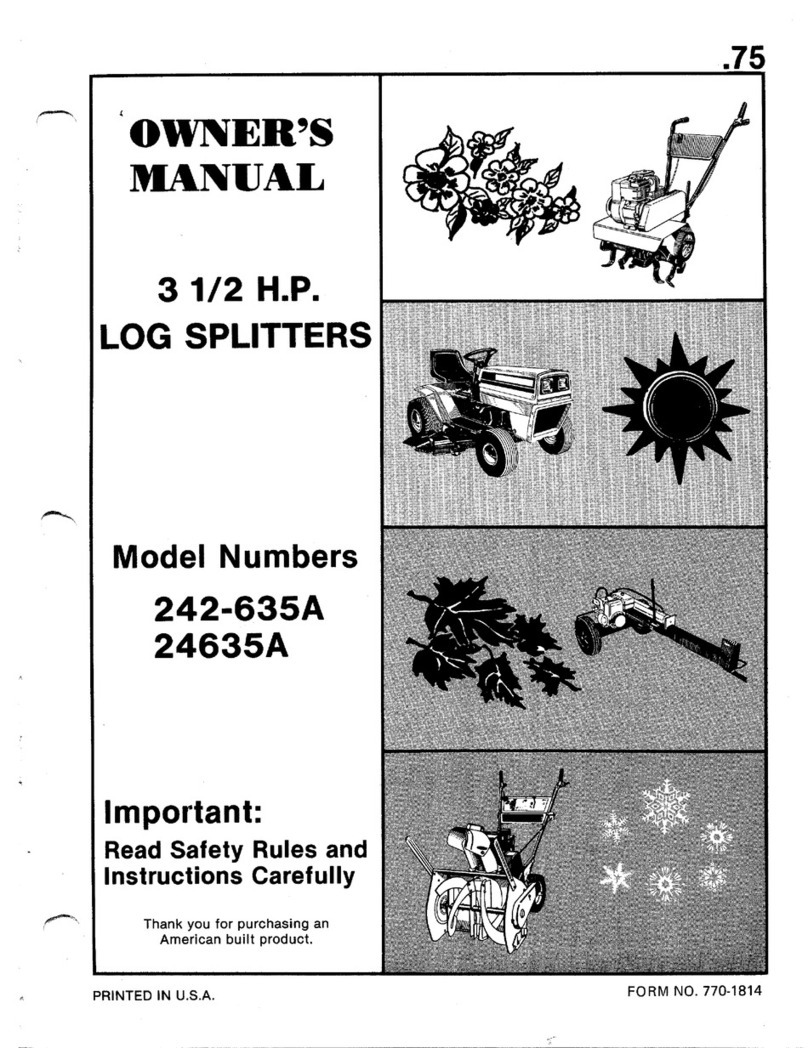
MTD
MTD 242-635A owner's manual

Champion Power Equipment
Champion Power Equipment 92221 Owner's manual & operating instructions
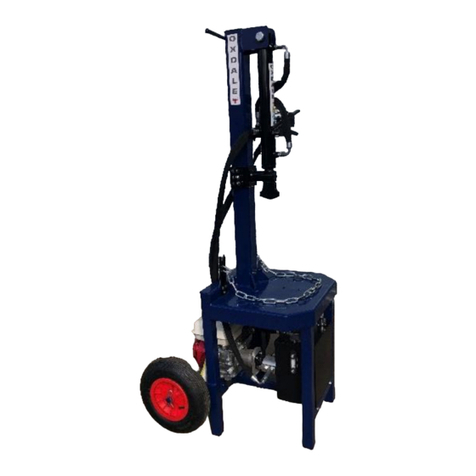
Oxdale
Oxdale se400 Operating and maintenance manual
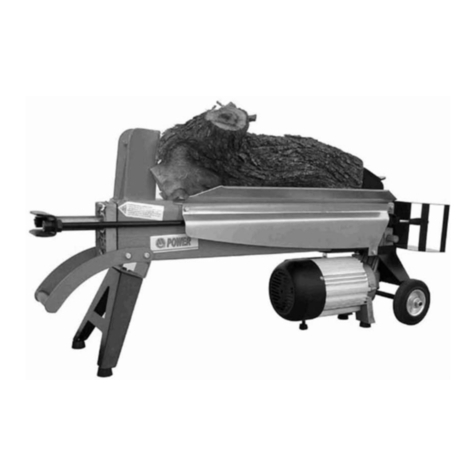
Master Quality Power
Master Quality Power YP3725 instruction manual
